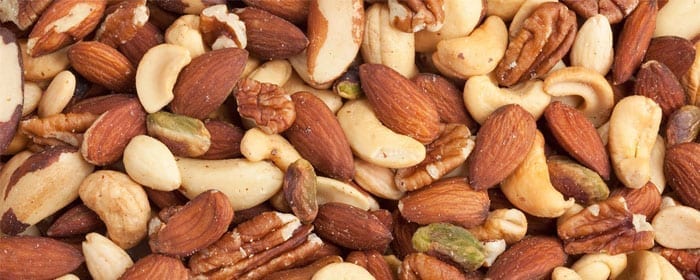
by admin | Apr 26, 2018 | Health Awareness, Multiple Sclerosis
Maintaining a healthy and nutritious diet is important in managing the symptoms of Multiple Sclerosis (MS). MS occurs when the body’s own immune system attacks the central nervous system. This can lead to potential symptoms such as numbness, fatigue, vision problems, bowel and bladder dysfunction, and movement challenges. Following a healthy diet can help play a significant role in dealing with these symptoms.
The National Multiple Sclerosis Society advises that there is no specific diet that can help cure MS since the symptoms of this condition tend to come and go. This makes it challenging to measure the effectiveness of any specific diet. However, following a diet that is low-fat and rich in fiber can be beneficial in helping with MS symptoms. Healthline has suggested some foods for those with Multiple Sclerosis to avoid or incorporate into a daily diet that may be beneficial.
Avoid Saturated Fats & Add Vitamin D
For good overall health, it is best to reduce fat intake to as low as 15 grams a day. You do not want to eliminate good fats or avoid cutting down in too many foods that contain Vitamin D. Some studies conducted by researchers at the University of Oxford and another conducted at the New Jersey Medical School have suggested that maintaining adequate levels of vitamin D may have a protective effect and lower the risk of developing MS and lessen the frequency and severity of symptoms. Some common foods that contain Vitamin D are liver, cheese, egg yolks and fatty fish like tuna and salmon.
Just Say No to Caffeine and Diet Drinks
Drinks that contain caffeine and aspartame can be a cause of irritation to the bladder. According to the nutritional guidelines provided by researchers, it is best to avoid such drinks especially if you experience bladder related symptoms.
What About Gluten?
A study that was published revealed that MS patients had high sensitivity to gluten. Before switching to a gluten free diet, have this tested to see if you do have an allergy to gluten. Gluten intolerance is a wheat-related disorder. Symptoms, including belly pain and bloating, occur after eating foods that contain gluten, such as, wheat, barley, and rye.
Opt for Fruit Instead of Refined Sugars
There is no evidence today that shows that refined sugar may lead to MS flare-ups, however, it is still suggested to cut back on sweet sugary foods to help manage a healthy weight. Additional intake of calorie rich food and sugar can lead to weight gain which has been linked to MS fatigue. It’s okay to have a slice of birthday cake once in a while but it is highly beneficial if you can choose fruit instead of food that contains refined sugar. Additionally, fruits are rich in fiber to help with constipation which can be a common symptom for MS patients.
Eat Well, Feel Good, and Live Long
Unfortunately, Multiple Sclerosis is a lifelong disease where the types and frequency of symptoms vary for each individual. There are various ways to help manage symptoms in order to have a better quality of life. Having a low-fat, high fiber diet will help provide energy, relief of some symptoms, and prevent additional health problems like heart disease.

by admin | Apr 23, 2018 | Health Awareness
Psoriasis is a chronic condition in which the immune system triggers an overproduction of skin cells. While it is a lifelong disease, its sufferers know to expect certain periods of flare-ups and other times when the condition’s symptoms are more manageable. Around this time of year, one question psoriasis patients often have is: How will the warm weather affect my skin? While the answer varies from one individual to the next, here is some information to help you stay comfortable through the coming heat waves.
Does Sunlight Help or Hurt Psoriasis?
Some individuals find that moderate exposure to natural ultraviolet light (sunshine) can lead to an improvement in psoriasis. In fact, light therapy is sometimes even performed under medical supervision as a means of controlling the condition. With that said, the National Psoriasis Foundation warns of overexposure: too much sun can actually cause a flare-up. Of course, prolonged exposure to sunlight can also increase skin cancer risks.
If you’ve experienced positive results with light therapy in the past, you may also find sunlight exposure to be beneficial. However, it’s a good idea to start slowly and gradually increase exposure times to no more than 15 minutes. Try getting five minutes of sunlight first, then build up durations over several weeks.
What Are Some Common Summertime Skin Irritants?
Unfortunately, the benefits of summer sun can be easily offset by increased sweating. In particular, people with psoriasis often experience increased flare-ups on their face and scalp as a result of the heat. Loose-fitting, breathable fabrics are best for keeping the skin cool. If you have scalp psoriasis, consider wearing white clothing during the summer time to keep any flakes undetected. Also, while air conditioning can provide relief, it may also cause skin to dry out. Be sure to moisturize daily if you’re staying in the A/C.
Bug bites are also known summertime irritants. While mosquito bites can be a nuisance for anyone, they can actually exacerbate symptoms in psoriasis sufferers. If you decide to apply bug spray, make sure it’s DEET-free, as the ingredient can also aggravate psoriasis. Should you prefer to keep your skin free of all insect repellents, try using citronella candles to ward off pesky insects instead.
Will Swimming Help?
Swimming can aid in the removal of dead skin, but both salt water and chlorine can also create dryness. To combat these effects, be sure to rinse off and moisturize shortly after getting out of the water. Hot tubs may also cause itchiness as a result of the heat, but for some people, the softening effect it creates on harder patches of skin makes the temporary discomfort worthwhile. Of course, if you have open sores it is best to stay out of the water until they have healed.
Ultimately, many people with psoriasis find that increased humidity levels and sunlight actually tend to outweigh any of the irritants summertime brings. In fact, most individuals find that warmer weather is a relief after cooler, dry winter months. With that said, each person responds to factors differently, so it’s always a good idea to listen to your body first and foremost.

by admin | Apr 20, 2018 | Health Awareness
Any time your body recognizes a foreign entity – whether it’s pollen, a chemical, a microbe, or something similar – it responds with inflammation. Persistent inflammation is a problem, because as Harvard Medical School explains, it is linked to serious diseases such as Alzheimer’s, heart disease, certain types of cancer, diabetes, and arthritis. For individuals already living with chronic conditions such as arthritis or diabetes, limiting inflammation is essential to controlling the impact of the disease. Thankfully, there are a few effective ways to reduce inflammation naturally, which we’ve shared here.
Eat Inflammation-Fighting Foods
One of the most effective ways to stop inflammation is to refine your diet to include inflammation-fighting foods. The Mediterranean diet has become popular in recent years due to its high volume of foods that fight inflammation. The diet comprises olive oil, fatty fish like salmon, and leafy greens, along with fruits like berries and oranges. Tomatoes, nuts, and whole grains can also help to keep inflammation under control. If you enjoy seasonings, try turmeric. It contains curcumin, which can help reduce the presence of free radicals and inhibit the production of inflammation.
Limit the Intake of Known Inflammation Triggers
Reducing your consumption of inflammation-causing foods is just as important as incorporating healthier options into your diet. No amount of fruits, vegetables, fish, or other nutritious foods can reverse the impact of foods known to trigger inflammatory responses. Try to avoid refined carbs like white bread and pasta, processed meat, soda, butter, and fried foods whenever possible. Additionally, make it a priority to reduce your intake of foods stored in plastic containers and select organic produce to limit your exposure to chemicals.
Stick to a Moderate Exercise Routine
Cardiovascular exercise gets your heart pumping, which boosts blood flow and helps you maintain a healthy body weight. Fat cells release cytokines, which prompt immune cells to create inflammation. Thus, the better you are able to maintain a healthy weight, the less inflammation you’ll experience. Aim for 30 minutes of moderate activity, five days per week. To stick with your routine, consider partnering with a workout buddy, signing up for a class, or even committing to a daily walk.
Improve Sleep Quality
Sleep is essential for cell repair and keeping the immune system on track, but most individuals aren’t getting enough high-quality, uninterrupted slumber each night. To facilitate deep sleep, be sure to shut off the TV before going to bed, and put your phone or tablet away at least an hour before bedtime. The blue light from screens can interfere with melatonin, a hormone which helps regulate sleep.
Adopt Healthy Stress Management Practices
Stressors are a natural part of life, and while it would be ideal if we could avoid them entirely, it simply isn’t realistic for most people. Because inflammation can be triggered by stress and anxiety, finding healthy ways for managing stressors can boost your overall wellness. From meditation to journaling, there are many options for alleviating tension. You may also want to try diffusing essential oils known for their calming effects (such as lavender), listening to music, or practicing yoga.
With these small lifestyle changes, you can make improvements in your inflammation levels to promote better overall wellness. Feel free to start slowly to see which tactics deliver the greatest results for you.

by admin | Apr 17, 2018 | Alzheimer’s Disease, Health Awareness
Whether you have been recently diagnosed with Alzheimer’s disease or you’re caring for someone with the condition, maintaining a high quality of life often means adjusting daily routines. While the precise types of adjustments needed will vary at different points in time, one way to manage stressors is to find coping strategies that effectively alleviate each challenge as it arises. Here, we explore some daily living tips you or your family members may find helpful.
Create & Follow a Daily Routine
Sticking to a routine can help ensure daily tasks get accomplished. It may help to follow a written plan each day. Also, many Alzheimer’s patients find that important appointments and other key tasks are best scheduled in the morning, when alertness is at its peak.
Focus on One Task at a Time
The Mayo Clinic explains that reducing distractions can help individuals improve their focus. Instead of doing housework while talking on the phone, for instance, devoting attention to one activity at a time may make it easier to concentrate.
Connect with Others
Socializing doesn’t just improve mood; it can also support mental health. According to a study conducted by the University of Michigan, even just ten minutes of social interaction can boost cognitive performance. Make a point to share meals with others, see friends, or stay active in the community to get plenty of interaction with others.
Find a Support System
Whether it’s church, a group that meets in person, or an online, there are many outlets for people living with Alzheimer’s to go for support. Family, friends, and even pets can also be sources of strength on particularly challenging days.
Recognize Triggers
Pinpoint any stressors that trigger anxiety or other negative feelings and find ways to actively avoid them. For instance, if feeling rushed leads to frustration, make sure others know that you need more time.
Keep Your Doctor’s Appointments
Attending doctor’s appointments can be difficult with transportation challenges, but according to the Alzheimer’s Association, doctors play a critical role in helping both patients and their families. Thus, it’s important to maintain scheduled visits whenever possible. Physicians and specialists can help patients select optimal medication for specific symptoms, recommend tailored disease management strategies, and provide treatment for any coexisting conditions. They may also have information about local clinical studies, which are becoming more prevalent as a result of accelerating research progress.

by admin | Feb 13, 2018 | Health Awareness
Various studies have shown heart-related benefits of nuts. Including at least 20-30 grams of nuts daily decreases the risk of heart disease by almost 30%. Everyday Health provides a few nuts that are beneficial in reducing the risk of heart disease and helping to maintain a heart-healthy diet:
Almonds can help lower cholesterol and body fat.
Including almonds in your diet can lower the LDL cholesterol levels in your blood that can lead to a heart attack. Studies also show that almonds can also reduce the risk of diabetes and improve the sensitivity of insulin. Almonds can also assist with weight loss and lowering body inflammation.
The truth on peanuts.
Peanuts have generally been thought to be the least healthy of the nuts. However, including peanuts, as well as peanut butter, in your daily diet can lower cholesterol and overall risk of diabetes. It is also a good alternative source of protein.
Pistachios help lower blood pressure caused by stress.
Pistachios can be beneficial for healthy heart management. They can help lower LDL cholesterol levels and risk of diabetes while also improving the heart rate response under stress. It is suggested that eating 1.5 oz. per day of pistachios may reduce the risk of heart disease and prevention of hypertension.
Walnuts keep the arteries clear.
Walnuts contain almost 47% of polyunsaturated fats which are known as “good fats”. Unlike most nuts, walnuts also have a specific kind of polyunsaturated fatty acid called the alpha-linolenic acid which is an anti-inflammatory agent that helps to reduce the buildup of plaque in the coronary arteries. Consuming walnuts can also help improve cholesterol levels as well as small vessel and artery function.
Can you eat too many nuts?
Yes, and you want to avoid overconsumption of nuts by eating them in moderation. They are a good source of energy and protein, but too many and in high amounts can lead to gaining weight. Be aware of any nut allergies in your family history as to avoid any allergic reactions.

by admin | Feb 12, 2018 | Health Awareness
February is officially known as Heart Health Month. Heart disease is the cause of one out of three deaths and the number one killer globally, but it can be preventable by making a few changes in both exercise, diet, and regular checkups. Everyday Health has a few tips to keep your heart healthy:
Monitor and maintain your blood pressure: Hypertension is a condition often ignored and left untreated by many but it is a big risk factor when it comes to heart disease. Monitor your blood pressure regularly and keep taking the medication. Follow up with your doctor regularly too.
Avoid smoking: Smoking increases the chances of heart disease by a factor of two to four. Heart disease is the leading cause of death for those that smoke compared to lung disease.
Avoid sugar: Studies show that Americans consume sugar more than an average person and it is a big contributor to the development of heart diseases. To reduce your sugar intake try replacing sodas with water or herb tea, choose fruits instead of baked goods or candies, and avoid processed foods as much as possible.
Eat healthily: Eat nuts, fruits, and vegetables as much as possible along with a good amount of whole grains. Try to have a weekly serving of fish, it reduces the risk of coronary artery disease and is highly rich in omega-3 fatty acids. Fish oil supplementation can also help protect against cardiac risks. Garlic is also known to be highly beneficial for heart disease. It lowers the cholesterol, maintains the blood pressure and decreases the number of platelets in blood preventing it from clotting.
Stay active: An inactive lifestyle increases the risk of heart disease. Regular exercise can help reduce this risk. Some studies have found that incorporating brisk walking in your daily routine reduces the three main causes of cardiovascular diseases, namely blood cholesterol, diabetes, and hypertension.
Some sun exposure is beneficial: Ultraviolet rays from the sunlight triggers the production of vitamin D in the body which lowers blood pressure. A daily exposure of ten to fifteen minutes of sunlight can help maintain proper levels of vitamin D.
Controlling stress levels: Stress can trigger the body to release hormones like cortisol and adrenaline that increase heart rate and blood pressure. These hormones can also make blood platelets to become stickier which can then cause blood clots and high blood glucose. This can lead to further risks of hypertension, diabetes, and atherosclerosis.
Getting enough sleep: A study review reveals that sleep deprivation can lead to heart risks including hypertension, coronary heart disease, and diabetes.
Maintain a healthy weight: Being overweight can lead to health issues including heart disease, high blood pressure, diabetes, and stroke. Even losing a few pounds will help provide cardiovascular benefits as you work toward a healthy weight goal. Talk to your physician about safe and monitored weight loss management.
Have some hibiscus or hawthorn tea: These teas offer a healthier option in place of sodas or sugary juices. Hawthorn tea has been proven to be effective for multiple heart issues and hibiscus helps lower blood pressure and cholesterol.







 St. Petersburg, Florida
St. Petersburg, Florida
